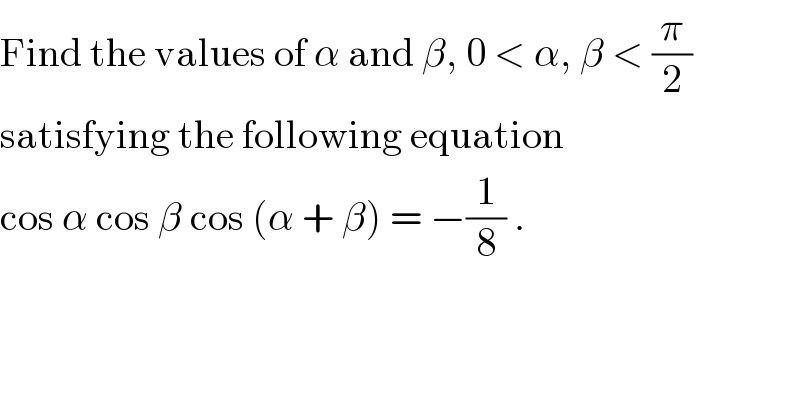
Question and Answers Forum
Question Number 15300 by Tinkutara last updated on 09/Jun/17

Commented bymrW1 last updated on 09/Jun/17

Commented bymrW1 last updated on 10/Jun/17
![F(α,β)=cos α cos β cos (α + β) let′s find the minimum of this function (∂F/∂α)=−sin α cos β cos (α+β)−cos α cos β sin (α+β) =−cos β [sin α cos (α+β)+cos α sin (α+β)] =−cos β sin (2α+β)=0 ⇒ sin (2α+β)=0 ⇒ 2α+β=π ...(i) (∂F/∂β)=−cos α sin β cos (α+β)−cos α cos β sin (α+β) =−cos α [sin β cos (α+β)+cos β sin (α+β)] =−cos α sin (α+2β)=0 ⇒ sin (α+2β)=0 ⇒ α+2β=π ...(ii) from (i) and (ii) ⇒α=β=(π/3) minimum =cos (π/3) cos (π/3) cos ((2π)/3)=−(1/8) ∴ for cos α cos β cos (α + β) = −(1/8) there is only one solution: α=β=(π/3)](Q15388.png)
Commented byTinkutara last updated on 10/Jun/17

Answered by Tinkutara last updated on 09/Jul/17
![8 cos α cos β cos (α + β) + 1 = 0 4 cos (α + β) [cos (α + β) + cos (α − β)] + 1 = 0 4 cos^2 (α + β) + 4 cos (α + β) cos (α − β) + cos^2 (α − β) + sin^2 (α − β) = 0 [2 cos (α + β) + cos (α − β)]^2 + sin^2 (α − β) = 0 sin (α − β) = 0 and 2 cos (α + β) + cos (α − β) = 0 ⇒ α = β and this gives 2 cos 2α + 1 = 0 ⇒ α = (π/3), as 0 < α, β < (π/2). So 𝛂 = 𝛃 = (𝛑/3).](Q17681.png)
